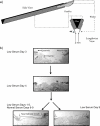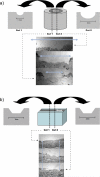The linear excisional wound: an improved model for human ex vivo wound epithelialization studies
- PMID: 21605167
- PMCID: PMC3863622
- DOI: 10.1111/j.1600-0846.2011.00528.x
The linear excisional wound: an improved model for human ex vivo wound epithelialization studies
Abstract
Background/purpose: Wound healing is a complex process that involves multiple intercellular and intracellular processes and extracellular interactions. Explanted human skin has been used as a model for the re-epithelialization phase of human wound healing. The currently used standard technique uses a circular punch biopsy tool to make the initial wound. Despite its wide use, the geometry of round wounds makes it difficult to measure them reliably.
Methods: Our group has designed a linear wounding tool, and compared the variability in ex vivo human linear and circular wounds.
Results: An F test for differences in variances demonstrated that the linear wounds provided a population of wound size measurements that was 50% less variable than that obtained from a group of matched circular wounds. This reduction in variability would provide substantial advantages for the linear wound technique over the circular wound punch technique, by reducing the sample sizes required for comparative studies of factors that alter healing.
Conclusion: This linear wounding tool thus provides a method for wounding that is standardized, provides minimal error in wound gap measurements, and is easily reproducible. We demonstrate its utility in an ex vivo model for the controlled investigation of human skin wounds.
© 2011 John Wiley & Sons A/S.
Figures



References
-
- Data and Trends Centers for Disease Control and Prevention. 2007 Mar 26; ( http://www.cdc.gov/diabetes/statistics/hosplea/diabetes_complications/fi...)
-
- Margolis DJ, Bilker W, Santanna J, Baumgarten M. Venous leg ulcer: incidence and prevalence in the elderly. J Am Acad Dermatol. 2002;46:381–386. - PubMed
-
- Phillips TJ. Chronic cutaneous ulcers: etiology and epidemiology. J Invest Dermatol. 1994;102:38S–41S. - PubMed
-
- Lees TA, Lambert D. Prevalence of lower limb ulceration in an urban health district. Br J Surg. 1992;79:1032–1034. - PubMed
Publication types
MeSH terms
Grants and funding
LinkOut - more resources
Full Text Sources
Other Literature Sources
Miscellaneous

